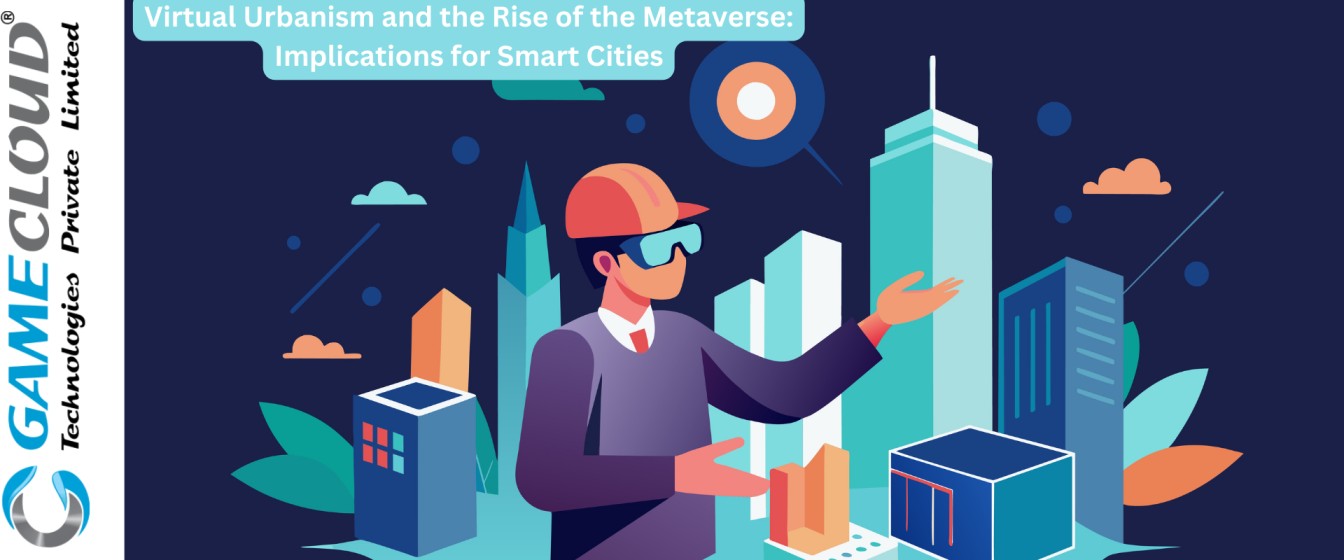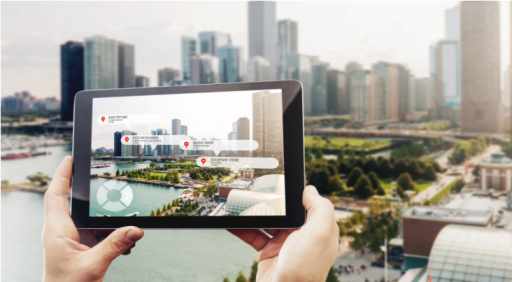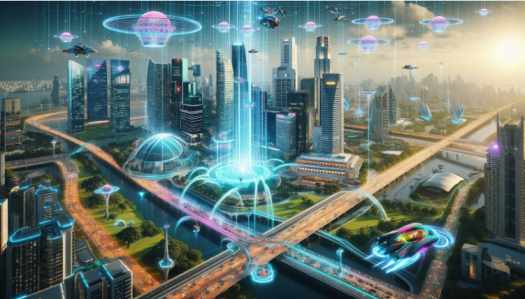
In recent years, the convergence of virtual reality (VR), augmented reality (AR), and game development has given rise to the concept of Metaverse. This digital realm, where users interact with each other and their environment through avatars, has profound implications for smart cities. In this technical blog, we delve into the intricacies of virtual urbanism, exploring its impact on urban planning, infrastructure, and citizen engagement.
Defining the Metaverse
Before we dive into the implications, let’s establish a clear definition of the metaverse. It is an interconnected network of virtual spaces, accessible through various devices, where users can interact, create, and transact. It transcends traditional boundaries, blurring the lines between physical and digital realms.
- Economic Impact: The metaverse opens up new economic opportunities. Virtual real estate, digital assets, and virtual goods become valuable commodities. Smart cities can explore revenue models by hosting virtual events, charging for access to specific areas, or facilitating virtual commerce.
- Environmental Considerations: While it reduces physical travel, it still consumes energy. Data centers that host its services require significant power. Smart cities must balance the benefits of reduced commuting with the environmental impact of increased digital activity.
- Accessibility and Inclusivity: It can bridge geographical gaps, allowing people from around the world to collaborate seamlessly. However, ensuring accessibility for all, including people with disabilities, becomes crucial. Smart cities should prioritize inclusive design.
- Health and Well-Being: Extended metaverse use can impact mental and physical health. Smart cities can promote healthy habits, encourage breaks, and integrate wellness features within virtual spaces.
- Education and Training: It offers immersive learning experiences. Smart cities can use it for virtual classrooms, professional training, and skill development. Imagine medical students practicing surgeries in a virtual operating room.

Architectural Challenges
Architectural challenges refer to the obstacles and complexities faced when designing and constructing virtual environments within metaverse. Let’s explore some of these challenges:
- Limited Design Tools:
- Designing structures in it can be challenging due to the limited availability of specialized design tools. Unlike traditional architectural software, which caters to physical buildings, its architects often work with novel platforms and interfaces.
- Solution: Its architects must adapt to existing tools or collaborate with developers to create new ones tailored for virtual environments.
- Technical Limitations:
- Building in the metaverse requires a significant amount of technical knowledge and expertise. Architects must understand virtual reality (VR), augmented reality (AR), and other immersive technologies. They must also grapple with issues like scalability, performance, and security.
- Solution: Continuous learning and staying updated on its technologies are essential for overcoming these limitations.
- Accessibility and Cost:
- Ensuring that its structures are accessible to many users is crucial. However, achieving accessibility while maintaining architectural integrity can be challenging.
- Additionally, creating high-quality, immersive experiences in it can be costly in terms of development time and resources.
- Solution: Architects should prioritize user experience and find a balance between accessibility and design complexity.
- Security and Privacy:
- As it becomes more integrated into our lives, ensuring user security and privacy is critical. Data breaches, unauthorized access, and privacy violations are potential risks.
- Its architects need to design secure spaces while allowing for seamless interactions and user engagement.
- Solution: Implement robust security protocols and educate users about privacy best practices.
Current Landscape of Virtual Urbanism
- Virtual Cities in Gaming: Games like “SimCity” and “Cities: Skylines” have long explored virtual urban planning, offering insights into complex city dynamics.
- SimCity (1989-present): The original city-building simulation game, SimCity allows players to zone land, plan transportation, collect taxes, and manage city services to grow a thriving metropolis. The game has evolved over the years, with the latest iteration, SimCity BuildIt, featuring a more detailed 3D environment and mobile-friendly gameplay.
- Cities in Motion (2011): Developed by Colossal Order and published by Paradox Interactive, Cities in Motion focuses on public transportation, challenging players to design efficient bus, tram, subway, and ferry networks to move citizens around the city.
- Cities: Skylines (2015): Considered one of the most successful city-building games in recent years, Cities: Skylines offers a deep and complex simulation with a wide range of customization options. Players can build residential, commercial, and industrial zones, manage traffic, and tackle challenges such as pollution and crime.
- Augmented Reality in Urban Navigation: Apps like Pokemon Go have demonstrated how AR technology can overlay digital experiences onto physical cities, creating an interactive and immersive urban exploration experience for users. By superimposing digital elements onto the real world through smartphones or AR glasses, AR apps like Pokemon Go have shown the capability of enhancing urban navigation by providing users with real-time information, interactive features, and engaging experiences within city environments.
- Virtual Meetings and Events: Platforms like AltspaceVR and Spatial are redefining how people interact in virtual spaces, hinting at the future of virtual urban gatherings.
Here is a detailed overview of the current landscape of virtual meetings and events :
- Urbanism Next Virtual Forum 2021: The Urbanism Next Virtual Forum held in March 2021 provided a global platform for experts, professionals, and enthusiasts to discuss emerging trends in urbanism, technology, and city planning. Virtual forums like this facilitate networking, idea exchange, and the exploration of cutting-edge concepts shaping the future of urban environments.
- South Beach Promenade Tactical Urbanism Virtual Meeting: This virtual meeting, focusing on tactical urbanism in South Beach, exemplifies how virtual events are utilized to discuss and implement urban interventions and strategies. Such meetings serve as forums for stakeholders to collaborate, share insights, and address urban challenges through innovative approaches.
- Cities in Action Virtual Webinar: The launch of the Cities in Action virtual webinar series signifies a shift towards online platforms for discussing urban development in Arab cities. These webinars provide a digital space for experts to present research, qshare best practices, and engage with a wider audience on topics related to urban planning, sustainability, and community development.
Virtual meetings and events in the context of virtual urbanism offer a dynamic and accessible way for professionals, researchers, and communities to connect, exchange ideas, and drive innovation in urban development. By leveraging digital platforms, these events transcend geographical boundaries, foster collaboration, and contribute to the advancement of sustainable and inclusive urban environments.

Implications for Smart Cities
- Data Integration and Analysis: Data integration and analysis play a crucial role in shaping the development and functionality of smart cities.
Here is a detailed exploration of the implications of data integration and analysis for smart cities based on the provided sources:
- Data Integration for Quantitative Analysis of Sustainability: The integration of data from various sources is essential for quantitative analysis in urban planning and sustainability initiatives. By consolidating diverse datasets, urban planners can gain comprehensive insights into environmental, social, and economic factors that influence the sustainability of cities.
- Research and Design of Data Integration System for Urbanization: Data integration systems in urbanization aim to collect and harmonize data from different sources, formats, and characteristics. These systems facilitate the aggregation of spatial data logic or physical data, enabling urban planners to analyze and interpret complex urban datasets effectively.
- Platform for Urban Analytics and Semantic Data Integration in City Planning: The development of a web-based platform for urban analytics and semantic data integration enhances the analysis, integration, and visualization of large-scale and heterogeneous urban data. This platform supports city planners in making informed decisions by providing a comprehensive view of urban dynamics and trends through data analysis and visualization tools.
2. Urban Simulation for Planning: Game engines like Unity and Unreal Engine are being used to create realistic urban simulations for testing smart city initiatives.
Here is a detailed exploration of the implications of urban simulation for planning smart cities based on the provided sources:
- Enhanced Decision-Making through Simulation: Urban simulation enables planners to create virtual models of cities, allowing them to simulate various scenarios and assess the impact of different urban development strategies. By running simulations, planners can make informed decisions regarding infrastructure development, land use planning, transportation systems, and environmental sustainability measures.
- Optimization of Urban Resources: Simulation tools help optimize the allocation and utilization of urban resources by analyzing data on population dynamics, traffic patterns, energy consumption, and environmental factors. By simulating different resource management scenarios, urban planners can identify efficient strategies to enhance resource efficiency and sustainability in smart cities.
Urban simulation is a powerful tool that empowers urban planners to model, analyze, and optimize urban systems, leading to more informed decision-making, efficient resource management, proactive planning for future trends, seamless integration into planning processes, and real-time monitoring and evaluation of urban initiatives in the context of smart cities.
3. Virtual Prototyping of Urban Infrastructure: Virtual prototyping of urban infrastructure is a key implication of the rise of virtual urbanism and the metaverse for smart cities. By leveraging game engines and virtual reality technologies, architects and urban planners can create realistic simulations of urban infrastructure projects before physical implementation.
Some key benefits of virtual prototyping for smart cities include:
- Optimizing designs: Virtual prototypes allow for iterative testing and optimization of infrastructure designs to enhance functionality, sustainability, and user experience.
- Identifying issues early: Potential problems or conflicts can be detected and resolved in the virtual model, reducing costly changes during construction.
- Enhancing stakeholder engagement: Immersive virtual walkthroughs enable better communication of plans to stakeholders like residents and policymakers.
- Streamlining approvals: Virtual models can facilitate the approval process by providing a clear, realistic representation of the proposed infrastructure.
- Enabling remote collaboration: Distributed teams can work together on virtual prototypes, overcoming geographical barriers.
Virtual prototyping utilises it and game development technologies to optimize smart city infrastructure, enhance stakeholder engagement, and streamline the planning and approval process. As virtual urbanism continues to evolve, virtual prototyping will play an increasingly important role in shaping the cities of the future.
Futuristic Trends and Predictions
- Metaverse Integration with IoT
The integration of it with Internet of Things (IoT) technologies presents a transformative landscape for the future. Key trends include:
- Data fusion for enhanced virtual experiences by providing real-time, context-aware information from IoT devices into it.
- Advanced IoT infrastructure to support the complexities of it, with cloud technology as a key enabler.
- Creation of digital replicas and simulations within it, leveraging IoT data and cloud platforms for realistic, immersive experiences.
- AI-driven Virtual Assistants for Urban Living
AI-powered virtual assistants will enhance future urban experiences by:
- Providing personalized services and optimizing city functions based on user preferences.
- Interpreting verbal instructions, executing tasks, and automating operations in smart homes and cities.
- Integrating with a wider range of products and expanding voice control capabilities to diverse languages and accents.
- Blockchain for Virtual Urban Governance
Blockchain technology may revolutionize how virtual urban spaces are governed in the future by:
- Ensuring transparency and security in virtual urban environments.
- Enabling decentralized decision-making and consensus mechanisms for managing virtual cities.
- Facilitating secure transactions, identity management, and data provenance in the Metaverse.
- Quantum Computing Advancements
Quantum computing is expected to make significant strides in the coming years, enabling:
- Exponential increases in computing power for complex simulations and data analysis.
- Breakthroughs in fields like cryptography, drug discovery, and climate modeling.
- The development of quantum-resistant encryption to secure future digital systems.

- Fusion of Physical and Digital Worlds
The convergence of the physical and digital realms will continue to accelerate, driven by:
- Advancements in AR/VR technologies for seamless integration of virtual and real-world experiences.
- The rise of digital twins and simulations for optimizing physical systems and processes.
- Increased adoption of brain-computer interfaces and neural implants for human-machine interaction.
These futuristic trends and predictions highlight the transformative potential of emerging technologies in shaping the world of tomorrow. As these innovations continue to evolve and converge, they will redefine how we live, work, and interact in the decades to come.
Real-World Examples
Here are the real-world examples that align with the context of Metaverse integration with IoT:
- Singapore’s Virtual Singapore: The Virtual Singapore project aims to create a 3D digital twin of the city-state for urban planning and disaster management. This initiative leverages IoT devices and data integration to develop a comprehensive digital replica of Singapore, enabling city planners to simulate scenarios, optimize infrastructure, and enhance disaster preparedness within the virtual environment.
- Epic Games’ Unreal Engine in Architecture: Architects are utilizing Unreal Engine, a powerful game development platform, to create immersive virtual walkthroughs of future buildings and urban developments. By integrating IoT data and real-world architectural designs into Unreal Engine, architects can visualize and showcase their projects in a realistic and interactive virtual environment, facilitating better communication with clients and stakeholders.
- Microsoft’s HoloLens in Urban Design: Microsoft’s HoloLens, an augmented reality device, is being employed in urban design projects to visualize and collaborate on city planning in mixed-reality environments. By combining IoT data with HoloLens technology, urban designers can overlay digital information onto physical city spaces, enabling real-time visualization, spatial analysis, and collaborative decision-making processes for urban development projects.
These examples demonstrate how the integration of IoT technologies with the Metaverse is being applied in real-world scenarios to enhance urban planning, architecture, and disaster management practices, showcasing the potential of these technologies to revolutionize the way cities are designed, managed, and experienced.
The Contribution of GamerThrong & QualityReality in Virtual Urbanism and the Metaverse
As the concept of virtual urbanism and the Metaverse continues to evolve, it is crucial to examine the role of innovative companies like GamerThrong and QualityReality in shaping this digital landscape. GamerThrong, a sub-brand of GameCloud Technologies, is dedicated to crowdsourcing gamers and technology users, leveraging GameCloud’s extensive experience in gaming to create a collaborative platform that ensures constant gameplay innovation and robust server operations. This platform allows for the testing and feedback of upcoming and unreleased games across various genres and platforms, providing valuable insights to developers and enhancing the overall user experience. QualityReality, another sub-brand of GameCloud Technologies, specializes in XR & Metaverse Services, offering comprehensive testing and development on XR platforms. Our team of experts are committed to pioneering Extended Reality solutions, ensuring that XR applications are functional, compatible, and performant across a variety of hardware configurations. By providing these services, both GamerThrong and QualityReality are contributing significantly to the development of the Metaverse, a key component of virtual urbanism, and its integration with smart cities.
Conclusion
Virtual urbanism and the metaverse are poised to revolutionize how we design, experience, and manage cities. Game development tools and technologies play a crucial role in shaping these virtual environments, offering new possibilities for smart city initiatives. As we navigate this digital frontier, the fusion of virtual and physical urban spaces holds immense potential for creating more efficient, sustainable, and engaging cities of the future.
